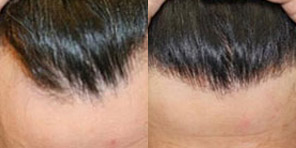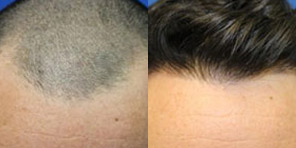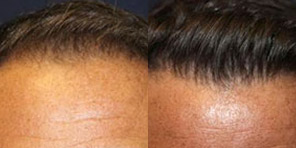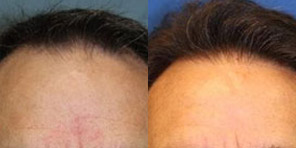An eyebrow transplant is a surgical procedure that restores full and natural-looking eyebrows. Eyebrows are important facial features because of how they contribute to our expressions. Additionally, eyebrow hair can take a longer time to grow back if over-plucked. A solution to this problem is an eyebrow transplant, which can provide patients with an enhanced appearance, and natural, seamless results.
At California Hair MD, we utilize follicular unit extraction (FUE) techniques to achieve the best results for patients in San Diego, La Jolla, Newport Beach, Corona del Mar, Beverly Hills, and beyond. Dr. Richard Chaffoo is a highly experienced, triple-board-certified plastic surgeon and hair restoration specialist. In order to schedule a consultation or learn more about eyebrow transplants, call us at (800) 373-4773 to arrange an appointment today. For our Corona del Mar location, please call (877) 942-2644. You can also fill out our contact form for further information.
Visit California Hair MD’s blog to find out more about different procedures. In addition to eyebrow transplants, we offer other individualized hair transplant services that have their own life-changing benefits.
Contents
About Eyebrow Transplants
An eyebrow transplant is a procedure that can help improve the way the eyebrows look using precise hair restoration techniques. There are a few different ways professionals can approach an eyebrow transplant, including using specialized tools and robotic assistance. (1) After your personal consultation, Dr. Chaffoo will determine which surgical technique will work best for you.
What is FUE?
FUE (follicular unit extraction) is an advanced method of eyebrow transplantation. (1) It involves the extraction of individual hair follicles from the donor area and their transplantation to the recipient area. One benefit of FUE is that it leaves behind much less noticeable scarring in the area where the donor hair was taken from. (1) The scars that FUE does leave are non-linear, meaning they are not in a straight line. This is due to the type of incisions Dr. Chaffoo will be making, which are called punch incisions because they target one follicular unit at a time. (1).
Benefits of FUE Eyebrow Transplantation
With an eyebrow transplant, patients can benefit from a fuller, more defined eyebrow shape. Other benefits of an eyebrow transplant include:
- Using FUE, we can precisely match the density of the eyebrow.
- Natural-looking result
- Short recovery time
- Increased confidence
- Long-lasting results (2)
Candidates
If you have suffered from eyebrow hair loss or the thinning of eyebrow hair, or have over-plucked your eyebrows in the past, you are probably a good candidate for an eyebrow transplant. However, a few things can determine if somebody should or should not seek out an eyebrow transplant. You may make a great candidate for an eyebrow transplant if you:
- Have realistic expectations for what the procedure can accomplish
- Are in good overall health
- Are willing to commit to extra eyebrow maintenance after the procedure
Personal Consultation
During a personal consultation at one of our offices, Dr. Chaffoo will talk with you about advanced eyebrow transplantation and how it may apply to you. He will examine your eyebrows and provide insights into how the procedure will work. He will let you know where the donor hair will be taken from, and if you are eligible for an FUE procedure. We offer personal consultations at any of our convenient locations in La Jolla, San Diego, Newport Beach, Corona del Mar, and Beverly Hills. Call us at (800) 373-4773 to schedule an appointment today. For Corona del Mar, please call (877) 942 2644. You can also fill out our contact form to learn more.
Preparation
Dr. Chaffoo will give you specific instructions about how to prepare your hair. In some cases, we can recommend some corresponding treatments or medications that can help optimize the results of your eyebrow transplant. (3) Other preparatory measures may include:
- Discontinuing blood thinning medications
- Stopping smoking
- Arranging transportation
- Planning for your recovery
Procedure
Your eyebrow transplant will look different depending on how much volume your eyebrows have lost, and what areas need to be addressed. Our team will use local anesthesia around the eyebrow areas to make sure you are comfortable during the procedure. Using advanced surgical techniques, Dr. Chaffoo will then fill and shape your eyebrows. An eyebrow transplant procedure will take about 3-4 hours to complete.
Recovery
The initial recovery time for an eyebrow transplant procedure is around 5-7 days. You will witness some scabbing during this time, but it is important not to pick at the transplant sites. This could impact your recovery time. There may also be some swelling and tenderness from bruising, which is completely normal and will subside in time. (2) After the procedure, patients may experience redness in the treated areas, but this side effect is also temporary and will fade within a few days.
During the first few weeks after your procedure, you may experience some shedding of the new hair follicles. This is simply an indication that the follicles are entering a dormant phase, or the phase that comes before new hair growth. Patients who undergo an eyebrow transplant enjoy a relatively short recovery time, but we recommend resting immediately after your procedure and avoiding touching the treatment site for some time. Dr. Chaffoo will provide you with a detailed recovery timeline, so you will know what to expect after your procedure.
Results
The results from an eyebrow transplant will be fuller, better-defined eyebrows. The eyebrows are important facial features, oftentimes determining how our facial features are perceived by others. They are also important to one’s individual identity; restoring a patient’s eyebrows can make them feel more like themselves again.
While it may take several weeks to see the final results, eyebrow transplants are permanent. The new hairs will grow slowly at first, and Dr. Chaffoo may recommend touch-up procedures or complementary treatments.
Cost of Eyebrow Transplants in San Diego, CA
The cost of your eyebrow transplant will depend on the treatment plan you and Dr. Chaffoo decide will work best for your unique situation. If you are looking into an eyebrow transplant and want to find out more details, please contact our office at (800) 373-4773 or share your questions with us in our contact form. We have five different locations that you are welcome to visit in person:
- San Diego: (800) 373-4773
- La Jolla: (800) 373-4773
- Newport Beach: (800) 373-4773
- Corona Del Mar: (877) 942-2644
- Beverly Hills: (800) 373-4773
FAQ
Does an eyebrow transplant look natural?
Hair transplant surgeons take great care to construct a brow that is both natural-looking and fitting to your facial features. Thanks to the precise techniques required of an eyebrow transplant, surgeons can meticulously define the eyebrow in a way that suits you.
How long does an eyebrow transplant take?
The process of an eyebrow transplant can take around 4-6 hours. The length of an eyebrow transplant changes depending on what method of transplantation Dr. Chaffoo decides is best for your situation, and whether you are addressing one or both eyebrows.
What hair is used for an eyebrow transplant?
The hair that is most commonly used during an eyebrow transplant is the hair from the back of the head, near the nape of the neck. This region is called the scalp-occipital region. However, it is possible to use other areas for hair, such as the legs or armpits. Based on your situation, Dr. Chaffoo will determine which areas would be best for use during an eyebrow transplant.
References
- Klingbeil KD, Fertig R. Eyebrow and Eyelash Hair Transplantation: A Systematic Review. The Journal of Clinical and Aesthetic Dermatology. 2018;11(6):21-30. https://www.ncbi.nlm.nih.gov/pmc/articles/PMC6011870/
- Sand JP. Follicular Unit Transplantation. Facial Plastic Surgery Clinics of North America. 2020;28(2):161-167. doi:https://doi.org/10.1016/j.fsc.2020.01.005
- Collins K, Avram MR. Hair Transplantation and Follicular Unit Extraction. Dermatologic Clinics. 2021;39(3):463-478. doi:https://doi.org/10.1016/j.det.2021.04.003






